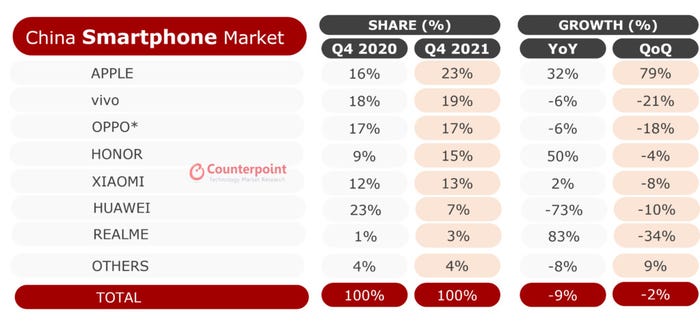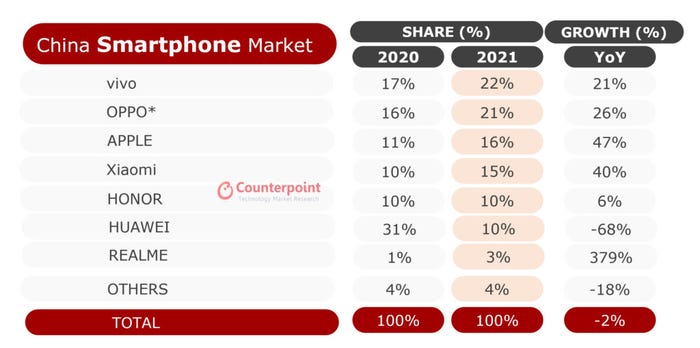Apple grabs top spot in Chinese smartphone market
According to the latest data from Counterpoint, US gadget giant Apple’s share of the Chinese smartphone market is growing rapidly.
January 26, 2022

According to the latest data from Counterpoint, US gadget giant Apple’s share of the Chinese smartphone market is growing rapidly.
Q4 2021 marked the first time Apple grabbed the top spot in China for six years. Given all the shenanigans going on between China and the West, especially the US, it’s a bit surprising to see a US company go from strength to strength in that country.
As you can see from the first table below, Apple’s share of the Chinese smartphone market jumped 32% year-on-year. The quarter-on-quarter comparison is less useful because Q4 is always Apple’s strongest quarter as that’s when the new iPhones come out.

“Apple’s stellar performance was driven by a mix of its pricing strategy and gain from Huawei’s premium base,” said Mengmeng Zhang of Counterpoint. “Apple rose to first place in China right after the iPhone 13 was released in September. Afterwards, it remained in the leading position for most of the fourth quarter. The new iPhone 13 has led the success due to a relatively lower starting price at its release in China, as well as the new camera and 5G features. Furthermore, Huawei, Apple’s main competitor in the premium market, faced declining sales due to the ongoing US sanctions.”
For the full year Apple is still third, behind Vivo and Oppo, but is gaining on them. As you can see from the second table, the overall Chinese market is in decline. “The market in China continues to decline due to various factors in both the supply side and the demand side,” said Counterpoint’s Ivan Lam.
“Firstly, the ongoing component shortages are impacting shipments of all OEMs. Secondly, China’s average smartphone replacement cycle is becoming longer. Smartphone designs within brands have also become more homogeneous, especially in hardware, failing to motivate consumers to upgrade. Lastly, China has been experiencing a complex economic environment where exports are driving the growth and domestic spending remains lacklustre.”

About the Author
You May Also Like












_1.jpg?width=300&auto=webp&quality=80&disable=upscale)
